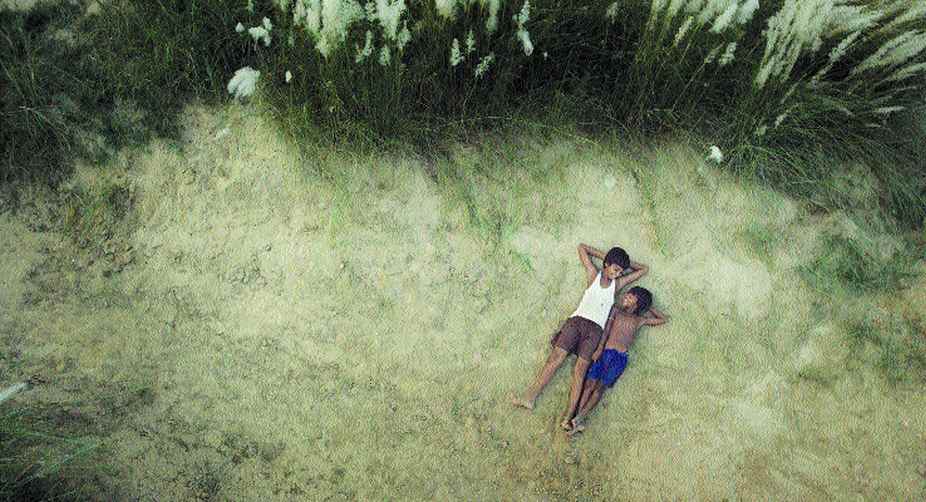Kalyani University unveils fourth volume of Aparajit Satyajit series on Ray
Vice-chancellor of Kalyani University Dr Amlendu Bhuiyan lighted the ceremonial lamp.

A scene from Sahaj Paather Gappo
Bengali filmmakers appear to be trying everything possible
to reverse the miserable trend that has gripped the industry in recent times.
The market crunch has made things worse but insiders confess in private that
the elimination of projects, which ought not to have been launched in the first
place, is not a bad thing after all. Till the cash crisis hit the industry, the
annual tally was more than 100 and they involved umpteen newcomers who had
either emerged from television or were former members of film crews trying
their hand at direction for the first time. This experience was far from
adequate but many of them perhaps ran into producers who were willing to plunge
into the adventure of film-making only to withdraw from the scene altogether
when the films sank within a couple of days of being released.
The irregular show timings make it difficult to keep track
of where and when these films are shown. But even if they are not seen in
theatres, they are entered for consideration in major events like the
Intern-ational Film Festival of India. Some of the regulations have been eased.
It is no longer necessary to have a clearance from the Central Board of Film
Certification — this allows films that are completed just before the deadline
to be entered. Inclusion in the festival is another matter. The fact that only
four of the 25-odd films entered for consideration this year were among the 20
selected after scrutiny may well cause disappointment in some quarters but no
one in the industry seems to have a plausible explanation for the rush of
amateurish work. Putting these films to the test in theatres is a challenge
that many of these producers are not prepared to face. It explains why many
films are never released or why an equal number disappear from theatres before
they can be properly assessed.
One film that was put to the test last week was Aguner
Pakhi, the story of a professor who goes out of his way to help a woman in
distress one night on a Kolkata thoroughfare — only to get embroiled in a
nightmarish situation after she dies in hospital. The story swings between the
professor’s family that comes under pressure from different quarters on account
of what is seen to be a social embarrassment and a television reporter who uses
all the tricks of the profession, including a sting operation, to unravel the
truth. The screenplay seems to be offering adequate doses of emotion and
excitement to keep the audience absorbed. But between the objective and the
treatment, there is a wide gulf that reveals the incapacity to throw up new
ideas either in terms of human appeal or dramatic twists and turns. The two
main characters are far too familiar and it is a pity that the script virtually
compels both Debshankar Halder and Rituparna Sengupta to perform well below
expectations.
Advertisement
The overwhelming impression is that of a cut-and-paste job
derived from entertainers that have produced dubious results. The professor has
a spotless reputation that cannot be tarnished under any circumstance while the
reporter carries the glamorous clichés that dilute her professional commitment
and make the outcome more than predictable. And, finally, there are too many
holes in the plot to make it a credible social drama or a worthwhile thriller.
Fortunately, this was not one of the films offered for
serious consideration in a festival. But there are many that have predictably
failed to leave any impression — without any regrets. On the other hand, two
films, yet to be released but shown in IFFI 2016, could well make a difference
in terms of serious response, if not in
terms of popular expectations. One of these is on the blind painter Binode
Behari Mukherjee with liberal inputs from the screenplay writer. Director
Saibal Mitra faced the tough task of getting away from Satyajit Ray’s treatment
of his teacher in Santiniketan in The Inner Eye. Mitra presents the same genius
from a different perspective and with sensitive human touches in Chitrakar —the
rough exterior concealing the softness of the heart and mind naturally linked
to the environment.
Ray’s documentary was an extraordinary depiction of a
natural genius through the eyes of the master. The new feature takes liberties
with the subject which may prevent the film from being considered a biopic.
But, in his handling of the blind painter, Dhritiman Chatterjee does rise to
the challenge.
The other film is Sahaj Paather Gappo, an extraordinary
debut by Manas Mukul Pal. It is a based on a short story by Bibhuti Bhushan
Bandopadhyay and depicts the innocence that survives in two young brothers
condemned to poverty and the grim struggle for livelihood in the heart of rural
Bengal. It is possible that a discerning audience will find touches of Pather
Panchali, more so because it comes from the same writer. But it has a cinematic
quality of its own in its visual treatment and its spontaneous depiction of the
wonders of childhood. How long the film will take to reach the theatres is
anyone’s guess. But it is surely justifies the promise that comes with first
efforts.
Advertisement